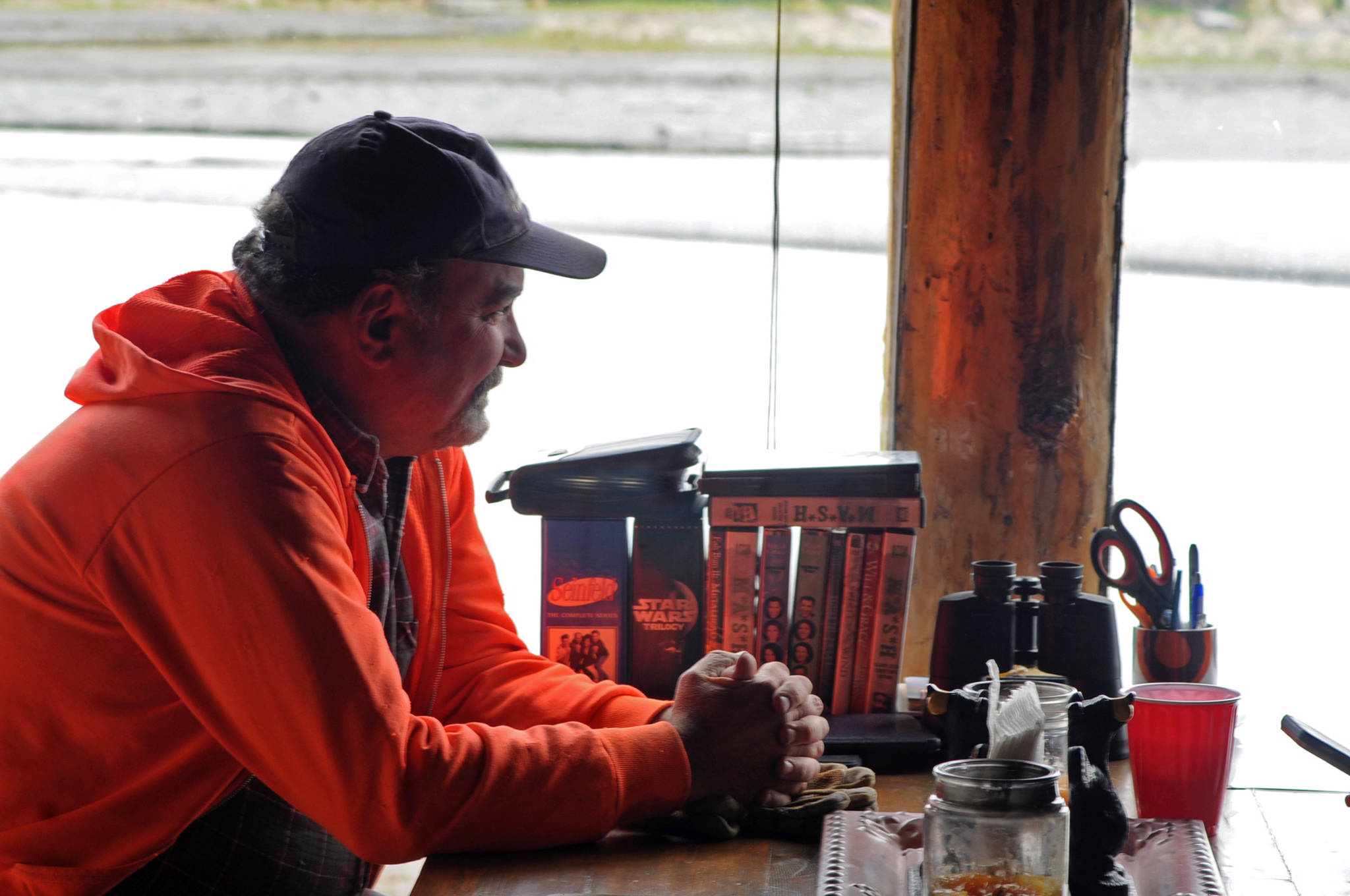For the past several years, property owners on Dow Island have been watching their land disappear into the Kenai River multiple feet at a time.
The small island, separated by a slough from the mainland along Funny River Road, hosts a number of summer cabins and homes along a muddy access road. Its northern shore takes the full force of the Kenai River as it comes around a bend before winding westward to Cook Inlet. Erosion is a problem all along the Kenai River, but the Dow Island residents have watched erosion accelerate significantly over the last few years.
Joe Losciuto, whose parcel sits in approximately the middle of the island’s riverside eastern bank, said his property used to be approximately half an acre. Today, it’s about a quarter of that size. Most of his plat is water, according to the Kenai Peninsula Borough’s online parcel viewer. And with the borough’s mandatory 50-foot setback for anadromous streams on private property development, he’s heavily hampered on what he can do on his property with so little land, he said.
“That cabin used to be on the front lawn,” he said, indicating his cabin and the small outbuilding that is now set alongside it. “If I hadn’t moved it, it’d be in the water.”
Natalie and Chad Smyre, who own a cabin at the northern end of the island, remember being shocked at the level of erosion in one day on their property.
“We went fishing one afternoon and came back and we’d lost five feet of bank,” Natalie Smyre said.
“Our dock was falling into the water,” Chad Smyre said.
Chad Smyre said they have owned property on the island for about seven years and have watched their property erode while the gravel bar on the far side of the river expanded toward them. Erosion is natural, but the increased boat traffic in the area has accelerated it, he said. As the king salmon fishery experienced more closures on the lower river and more guides and private anglers began moving into the middle river to fish for trout and sockeye, it added to the pressure. The traffic has grown dramatically in the last several years, he said.
Over time, the property owners have tried to install revetments along the bank to protect it from excessive erosion. They tried a spruce tree revetment, which involves setting bundles of spruce trees into a bank with an anchored cable and rebar, but the river proved too tough for the restoration, especially with the high water and floods in 2012, Chad Smyre said.
Then Steve Flick bought the property upstream of them on the island. A professional construction contractor with a background in environmental engineering projects, Flick proposed a different type of bank restoration that he said would be a more permanent solution.
It took four years and nearly $500,000, but Flick, the Smyres and two other property owners completed their project on the island in three weeks and two days this spring.
The workers, who are Flick’s employees in his company in Missouri, excavated the bank and laid long tree trunks with the root wad complex still attached to face the river. Atop that they layered additional logs, fill, a fabric layer and thousands of bundles of willow cuttings that will eventually net into a vegetative system to keep the bank stable. Beneath the bottom layer of the logs are cables every 20 feet that run about 7.5 feet into the bank to keep it stable, Flick said.
“This should last 50 years,” he said.
Much of the work was ahead of the actual construction, Flick said. One of the most important parts was to identify the toe of the eroded bank and make sure the project went far enough down to control it. Banks tumble down and ooze out from the bottom, so controlling the bottom of the eroded area is paramount, he said.
“If you don’t control the toe, you don’t stand a chance,” he said.
Originally, the property owners had the idea of approaching the government for match funding to restore the bank. The Alaska Department of Fish and Game coordinates a program with the U.S. Fish and Wildlife Service to provide cost-sharing assistance for property owners who want to restore their riverbanks using proper techniques for salmon habitat in the Matanuska-Susitna Valley, the Fairbanks area and on the Kenai Peninsula. The landowners on Dow Island applied through the cost-share program but were denied for this year based on lack of funding and told to apply again next year, they said.
“If we waited, (the Smyres’) cabin would be in the river,” Flick said.
So they went forward on their own. Flick’s company donated much of the environmental work and worked at cost to reduce the expense of the project, but the landowners are still going to be paying off the project for years, the Smyres said.
But it’s better than having no property by the time the river is done with it, Chad Smyre said. He estimated that with the restoration project, they gained back about 2,700–3,000 feet of land.
“Before we did this project, it was zero value,” he said. “Nobody would buy it.”
The property owners want more landowners along the river to know about the restoration technique they used — although it’s been done in the Lower 48 and has similarities to the rootwad restoration technique used around Alaska, Flick designed this particular project and it uses techniques new to the state, he said.
“I wanted to make sure, if I put this in, it’s going to be here 50 years from now,” he said.
Reach Elizabeth Earl at elizabeth.earl@peninsulaclarion.com.

